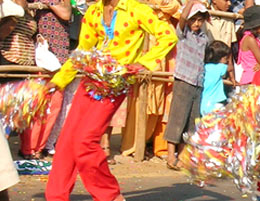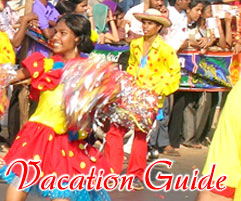The
funkiest fest of India, Goa Carnival is a three-day long festival. King
Momo introduced Goa Carnival just before the Lent season of the
Christian calendar. According to Christianity, Lent is the 40-day period
of fasting and penance before the Easter Sunday meant to purify one's
soul. An adaptation of the Roman carnival, this tamer version in Goa
usually starts off on Fat Saturday known as 'Sabado Gordo' and concludes
on Fat Tuesday known as 'Shrove Tuesday', just before Ash Wednesday that
starts with the first day of the season of Lent. Yet the Carnival in Goa
is a madness of sorts. A few years back, it was better known as a
Christian festival and everywhere one could see Carnival floats, balls
and street dances taking over the streets of Goa.
Carnival in Goa in its early days was the time when the white masters
and their black saves mimicked each other as the brown natives watched
them in awe. The whites masqueraded as black slaves while their slaves,
generally from Mozambique, plastered their faces with flour and wore
high battens or walked on stilts. In due time, the old crude mimicry
evolved into a social satire. The native rural play-writers wrote theme
for Khel ('playi' in Konkani) while the Portuguese Governor General, his
family and retinue showered the crowds with poudre de riz and confetti
and danced with anyone who wished for a dance with them.
In 1922, Dr. Jaime de Morais, the then Governor General of Goa,
transformed the entire area around the 'Palacio do Hidalcao' into a
'fairy land' as he waged a mock war with the children of Panjim from the
verandah of his palace using powder bombs, bags of perfumed powder,
flowers and sugarplums. Balloons bobbed up in the air with multicolored
trails and a colorful procession featuring horse-drawn carriages,
decorated bullock carts and gorgeously bedecked floats were the
highlights during the 3 days. Then Goa Carnival was not just a
celebration. It was a mood and was strictly for participants as people
sang and danced all nights long. The couple that fell in love during the
carnival married after Easter. Today, visitors unacquainted with the
Goan way of life are often stunned to see the locals singing and dancing
practically non-stop for four nights and three days and drinking by the
barrel without getting drunken. Revelers greet each other with a
full-throated 'Viva Carnaval'.




